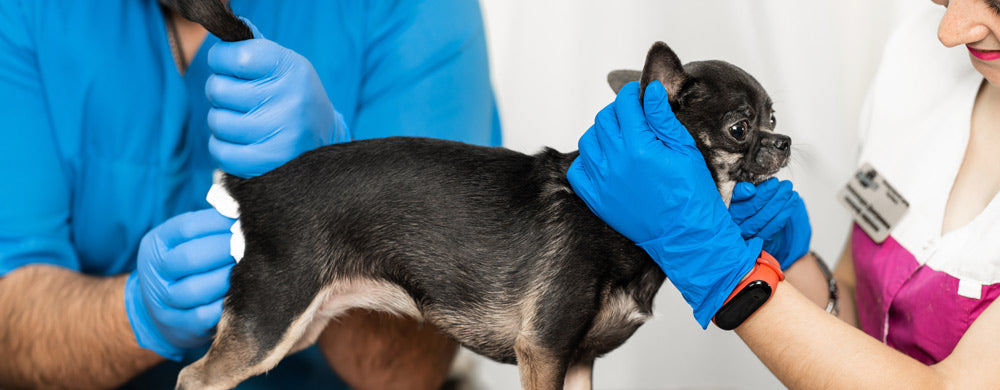Your basket is empty

Why Is My Dog Itching? The Causes of Itching in Dogs
September 07, 2021 9 min read
Every dog owner would notice his pet scratching itself from time to time. A dog's scratching is more frequent during moulting, which is quite natural then. However, it should be quickly assessed if the dog scratches itself excessively and intensively and licks and rubs itchy spots on the body. Itching significantly reduces the dog's quality of life and well-being. Sometimes it can be so annoying that neither the dog nor its guardian can even fall asleep peacefully.
Itching in dogs manifests itself in a variety of ways. It is most noticeable when the dog scratches itself in certain places on the body with its paws or rubs against furniture. For example, if it shakes its head insistently, it may be itchy in the area around the ears. In many cases, unfortunately, it does not stop the itch itself. By constantly scratching the skin, inflammation is formed, and bacteria, yeast and other microbes can enter the dog's body and cause an infection. A skin infection aggravates the itching, making the dog scratch harder and more frequently - the vicious cycle starts all over again.
***
The causes of itching in dogs
Itching is one of the most common reasons for vet visits. Several factors and conditions can cause itching. The most important of them are described below.
A discrepancy is made between the primary and secondary causes of itching. Causes of primary are those when itching occurs first, and then visible changes appear on the skin. In the case of secondary causes, changes in the skin appear first, followed by itching.
Predatory mite
This type of mite is often underestimated, but it is not uncommon. Predatory mites can be seen in dogs, cats and rabbits. They are transmitted through direct contact and contact with the environment. They live on the surface of the skin and feed on tissue fluids. Itching caused by the presence of predatory mites can be of different intensity and range, most often affecting the back, shoulder blades and outer side of the dog's ears. It is typical that the skin flakes, especially on the back.
Scabies mite

Canine scabies is host-specific, very contagious and is known to transmit to humans. You can become infected through direct contact with an infected dog or through contact with its surroundings. Canine scabies carries out tunnels in the keratin layer of the dog's skin, lays eggs and leaves dirt there. It eats dead skin cells and tissue fluid. The itch is caused partly by their presence and an allergic reaction to their waste products. Although itching is often constant, it also accompanies the dog at night and when eating or playing. The most common itch is caused when scabies occurs on dog's ears, joints, belly and chest. Later, in the advanced stage, all over the body.
Autumn itch
Fall itch is an orange-red pinhead-sized mite that is most common in summer and fall. The larvae of this mite feed on the host's extra fluid that drains from cells and tissues. The itches lurk in the tall grass and attack the feet (between the toes), stomach and head of the dog primarily. Especially in sensitive animals, the bite of such a larva may provoke an allergic reaction accompanied by severe itching. Also, after removing these parasites, the itching may not stop anytime soon.
Ear mite
Ear mites mostly affect the outside of the ear and sometimes also around the ears. At all stages of development, these mites feed on the dog’s outer tissue fluids and dead skin cells. They are transmitted through direct contact with an infected animal - most often by puppies, less often by adult dogs. Typical symptoms of ear mite infestation are annoying itching in the ears and the surrounding area.
Fleas
Invasion fleas are a common cause of itching in dogs. Fleas are passed on to dogs by other hosts or—in the young stages of development—from the environment. Flea itch is most common on the back and the base of the dog's tail, as well as the abdomen, the insides of the thighs and the neck. Hypersensitivity to flea saliva allergens can cause FAD in dogs, i.e., flea allergy dermatitis.
Atopy
Atopy is an allergy to environmental allergens, such as pollen, grass, dust mites and mould. The itching then occurs "seasonally", for example, when flowers are pollinating. Allergens enter the body through the dog's skin. The most common areas of itching in a dog's atopy are the muzzle and paws, the abdomen, the inner thighs, and often the ears. Prolonged scratching can further damage the skin and aggravate itching.
Allergy
A variety of allergies can cause itching in dogs.
In the case of contact allergy, virtually any allergen (plant or synthetic) in a sensitive dog can lead to an allergic reaction at the point of contact. It is often an area that is not covered with hair. Usually, itching occurs only at the site of contact with the allergen.

Flea allergy dermatitis is the most common allergy in dogs. It is caused by any type of flea, most often by the cat flea, which is not very picky about the host. Allergens contained in the saliva of the flea enter the dog's body when bitten. A small number of fleas, sometimes just one, is enough to trigger an allergic reaction in a dog. Affected dogs suffer from itching, especially in the rear part of the body: on the back, root of tail, tail, hind legs, abdomen. With severe itching, dogs scratch a lot and even bite so that they can make additional skin changes apart from flea bites. In addition, these wounds can be infected by bacteria or yeasts, causing the itching even more troublesome (secondary infection).
With food allergies, an allergic reaction occurs through a specific ingredient of the dog's food. It is the third most common allergy in dogs, after flea allergy and atopy. The trigger for an allergy is often a food ingredient that the dog has been eating for a long time. Allergens enter the body through the intestines. Food allergens are protein particles, most often drawn from beef, milk and dairy products, eggs, chicken, fish and soybeans. The areas that itch most often with this allergy are like those with atopy. The itching usually occurs 4 to 24 hours after the dog eats the allergen.
Fungal infection (dermatophytosis)
Occasionally, infection with a fungus may lead to itching. Although fungal infections in dogs are rare - they only appear due to immunosuppression, insufficient care or contact with an infected animal. Infection happens through bacteria from the environment. Therefore, itching occurs in those places on the body that have been in direct contact with the bacteria.
The causes of itching are mainly systemic diseases in which the immune system is weakened. Due to diseases such as hypothyroidism, Cushing's syndrome (hypercortisolaemia) or autoimmune diseases, various changes in the skin and coat of the dog develop. These happen due to deficiencies in the protective layers of the skin, weakening of the immune system, slowing down the hair cycle, or, in the case of Cushing's syndrome, of thin, inelastic skin resulting from the overproduction of cortisone. These conditions first appear as lesions of the skin without itching. However, due to changes in the structure of the skin and lowering the immune system’s efficiency, bacteria and yeasts have a much easier job. They settle on the changed skin and cause infection. They are called secondary infections, developing based on existing diseases. They cause itching. Its intensity depends on the power of the secondary infection.
Demodicosis
Demodex lives in hair follicles, sebaceous glands and veins. Like other mites, it feeds on sebum and skin cells. However, it is not dangerous for the animal, and its presence does not cause allergic reactions. But even a temporary drop in the pet's immunity is enough for the mite to seize the opportunity and begin to multiply rapidly, causing the dog's skin to change. In demodicosis, itching occurs when bacteria and yeasts appear in the skin wounds, so it is a secondary illness.
***
Diagnostic management of a dog’s itching
Because there are so many different causes of itching in dogs, an entire medical history and careful diagnosis are essential. The following points should be analysed:
- The breed, sex, age, size and weight of the dog
- The rate of similar symptoms in parents or siblings from the dog's litter
- The localisation of itching on the body
- Season
- Whether the itching occurs in other animals or people in the household
- Pre-treatment susceptibility to specific therapy
- Whether the itching occurred before or after the appearance of the skin wounds
Based on this data and a clinical examination, the vet can start making a diagnosis.
Ectoparasites are often the cause of an itch and are usually not difficult to spot. If no test shows the presence of parasites, but suspicion of their existence is still high, various anti-parasitic measures are taken, and the effects are investigated.
Bacteria and yeasts can cause itching. They are detected by an antibiogram or cytological examination. If bacteria or yeasts are present, determine what is causing them.
Diagnosing allergies is a slightly more complicated issue than in the case of a bacterial or fungal infection. Unfortunately, there are no simple tests to show which allergies your dog is suffering from. Instead, you must proceed in a sensible and structured manner to discover the cause of the allergy. The diagnosis of contact allergy is relatively easy because itching occurs locally on the body after contact with a specific substance or material. For other types of allergies, the so-called exclusionary or elimination diagnostics are recommended. This means that allergies are ruled out in sequence.
It begins by ruling out the most common and easiest allergies to diagnose, such as flea allergy dermatitis. If the therapy is unsuccessful, it moves on to determine the potential presence of food allergies. For this purpose, elimination diets are used. For a minimum of 6 weeks, the dog is fed with meals containing only one source of protein and one source of carbohydrates. If the allergic reaction does not occur and the symptoms stop, the dog is given the previously given food - this is called a provocation. If the dog shows old symptoms again, this is a confirmation of the presence of food allergies. However, in the absence of the satisfactory effects of an elimination diet, another suspicion appears - atopy. This process helps you to determine what is the reason for the dog's itching.
***
Itching therapy
In the case of a very troublesome itching, it may be necessary to relieve the dog’s suffering during diagnosis somehow. This is possible thanks to effective medications given with food or topical therapy, such as washing the dog with a special shampoo. Nevertheless, the cause of the itching cannot be ignored, even when the treatment helps. Therefore, in order to help your dog in the long term and combat the cause of the itch, you should find it and target the source with therapy.
If your dog is found to have ectoparasites, your veterinarian may recommend administering appropriate anti-parasitic agents. The treatment may also include the regular administration of an anti-flea preparation.
Depending on the severity of the fungal disease, therapy with lotions or extracts or systemic therapy with antifungal preparations is used. It should be determined whether a given dermatophytosis is a zoonosis, which means that a person could be infected with it from an animal. Sometimes, in the case of mycosis in a dog, it is necessary to use preparations in the animal's environment.
The only way to cause atopy to be treated is desensitisation - allergen-directed immunotherapy in which the dog is deliberately given a concentrated dose of a specific allergen. The aim is to stimulate the dog's immune system and thereby achieve tolerance to the itchy allergen. Unfortunately, this is not a very pleasant treatment. Usually, it initially aggravates the symptoms, which is why additional treatment with soothing agents is used. There is also another type of itch treatment for atopy - biological treatment with monoclonal antibodies. So far, this type of therapy shows great promise and is well tolerated by dogs.
Essential fatty acids like Omega 3s may also help reduce itching. These contain DHA and EPA fatty acids found in fish oil. These fatty acids reduce the inflammatory response in the body. This calming effect reduces the number of histamines released by white blood cells, reducing itching and scratching in your dog.

Dog's Lounge SALMA- Scottish Salmon Oil with Omega 3 is suitable for dogs and puppies. Salmon oil is widely used to promote a healthy and glossy coat, maintain joint health, soothe dry and itchy skin, support a healthy immune system, and maintain heart and brain health.
Our oil had been gently and ethically extracted from prime Scottish salmon and micro-filtered to ensure the oil's purity. Rich in naturally occurring Omega 3s and other antioxidants, our product is immediately utilised by your pet's body. This effect soothes and cools the inflamed and red skin.
Our other product - OMEGA, comes in soft gel tablets, making them easy to swallow and digest. It contains Omega 3, 6, 9, which helps to look after your best friend's skin and coat, making it shiny and healthy whilst bringing relief to dry skin, itching and allergies.
Secondary infections - bacterial or fungal - can be combated with local antibacterial or antifungal agents (shampoos, ointments, sprays, etc.) or with antibiotics. However, you should always find the cause of the infection and focus primarily on treating it.
***
Final Thoughts
You need to pay attention to disturbing symptoms because scratching can signal something wrong with your pet. The key to solving the problem is to determine the reason why your dog is itching.
First, it'll be necessary to visit a vet. After interviewing the owner and a thorough examination of the dog, he/she will confirm the diagnosis and suggest appropriate treatment.
Itching may result from dermatitis, the appearance of parasites on the dog's body, but it can also result from feeding and taking care of the pet. Remember that dry dog food must be high quality, and do not forget about the pet's hygiene. Please, do not wait for your companion's condition to worsen, as itching may cause significant discomfort and stress in the animal.
Also in Pet Advice

Should You Add Water to Your Dog’s Kibble? Here’s What the Science Says
August 14, 2025 7 min read
Should you add water to your dog’s kibble? Discover the science-backed pros, cons, and better alternatives like bone broth and fresh food to improve hydration, digestion, and overall canine health...

DIY Frozen Dog Treats Your Pup Will Love
June 27, 2025 4 min read
Summer heat can be dangerous for dogs, making hydration more important than ever. Learn how to spot signs of dehydration, boost your pup’s water intake, and create fun, frozen recipes to keep them happy and healthy all season long.

Why Is My Dog Scooting? Common Causes and How Diet Can Help
May 09, 2025 4 min read
If your dog is scooting or smells fishy, it could be due to blocked or irritated anal glands. Learn what causes blocked anal glands, which dogs are most at risk, and how simple dietary changes—like adding fibre and anti-inflammatory nutrients—can help prevent recurring problems.
